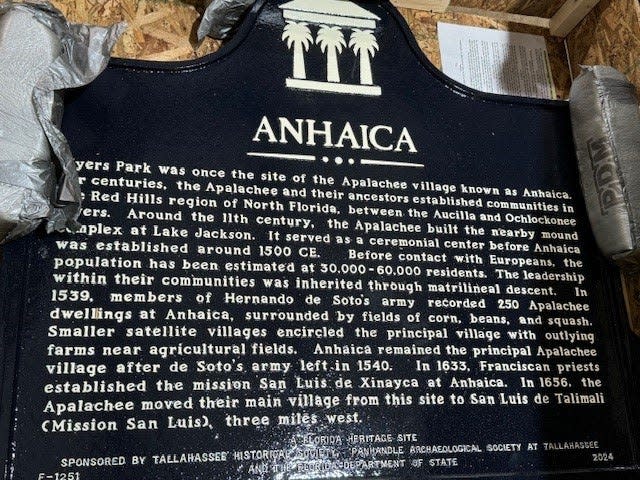Historical marker commemorates Native American city of Anhaica

A touchstone to Tallahassee's past is next to the tennis courts in Myers Park.
It is now the site of a historical marker commemorating the Apalachee city of Anhaica and the Native Americans who lived in Tallahassee at the time of European contact.
Anhaica had at one point as many as 60,000 residents, according to the language on the marker.
"Envision this whole hillside stretching down to the Capitol as a teaming, busy, massive Native American cultural and governmental center," said Tallahassee Historical Society president Bob Holladay. "This is what was waiting here when Hernando de Soto and the Spanish got here in 1539."
The marker is a joint collaboration between the historical society and the Panhandle Archaeological Society at Tallahassee (PAST) to celebrate the city's bicentennial, and was unveiled at an event on Friday evening.
The Anhaica historical marker is the third of 10 the historical society is installing over the next year.
The Apalachee province was a region that stretched over the Florida Panhandle, and Anhaica was its center. The indigenous people lived in large towns with huge fields of corn, beans and squash on the perimeter, said Andrew Frank, a Florida State University professor of Native American history.

"The Apalachee were not this primitive backwards looking society, but were urban agriculturalists that had specialized craftsman, modern technologies that were destroyed by the Spanish," said Frank.
The site is also notable as it believed to be the site of the first celebration of Christmas in the New World, as de Soto brought 69 Catholic priests on his expedition, which ended four years later in Mexico.
De Soto's Christmas in Tallahassee wouldn't have been a very pleasant one, according to historians. The Spanish conquistador and his 600 camp followers were occupying the Apalachee Indian capital of Anhaica and were under constant attack. While accounts of his expedition don't mention a Christmas ceremony, historians don't doubt it happened.
De Soto and his army of Spanish and Portuguese soldiers camped here from Oct. 6, 1539, to March 1540 after taking over the village. The encampment is the oldest known European building site on the North American mainland, predating the founding of St. Augustine in 1565 and Jamestown in 1607 by several decades.
"It was a large expedition," a state historian said in a 2013 article in the Democrat archives. "There were several Franciscan friars accompanying him who would have celebrated Mass on Christmas day. And de Soto and his troops, being Catholic, would have participated in the celebration."
The marker will be placed feet away from the tennis courts, which was once the site of Florida's first territorial governor William Pope Duval's home.
Duval, who governed Florida from 1822-1834, played a heavy hand in Native Americans' removal in the Florida Panhandle.
"I think it is really important that as we celebrate the 200th anniversary of Tallahassee that we remember that this part of Florida has been occupied for centuries before it became incorporated as Tallahassee," Frank said. "Tallahassee means old town, and that old town, which was here before Andrew Jackson, was Muscogee, and before that was Apalachee."
This story is part of TLH 200: the Gerald Ensley Bicentennial Memorial Project. Throughout our city's 200th birthday, we'll be drawing on the Tallahassee Democrat columnist and historian's research as we re-examine Tallahassee history. Read more at tallahassee.com/tlh200. Staff reports from the Tallahassee Democrat archives contributed to this article. There are still about two dozen copies of a book of Ensley's columns available exclusively at Midtown Reader, 1123 Thomasville Road, or midtownreader.com. Proceeds from the sale of the book and contributions have been used to establish an endowed scholarship for budding journalists at FSU, and have also brought this project to life in celebration of our 200th anniversary
This article originally appeared on Tallahassee Democrat: Tallahassee historical marker honors Native American city of Anhaica
